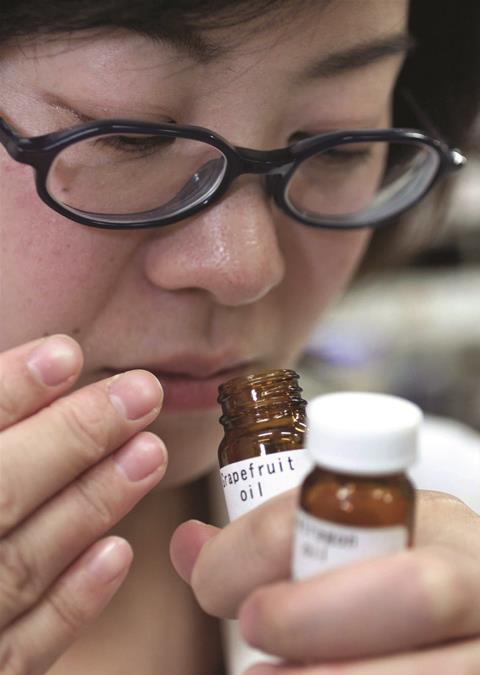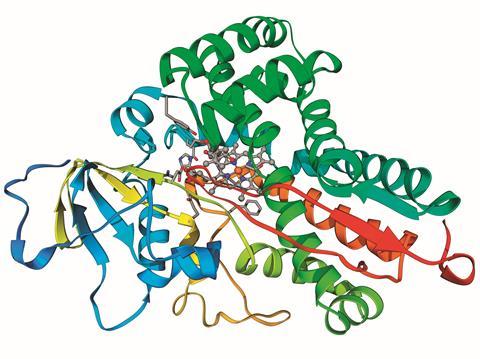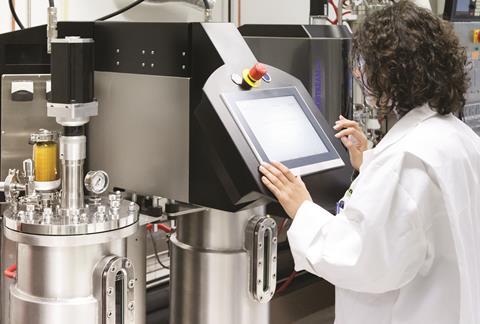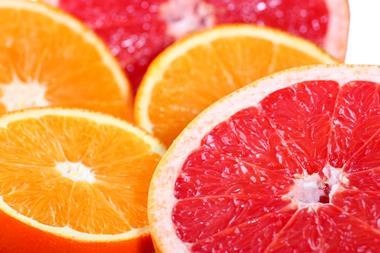After years of research, the flavour and fragrance industry is increasingly turning to biotechnology for commercial production, as Emma Davies reports
The fragrance and flavour (F&F) industry has a long history of closely guarded secrets. After years of work behind closed doors, commercial F&F molecules produced using engineered microorganisms are edging onto the market. The first such chemicals are staples such as patchouli, of incense fame, and grapefruit’s characteristic compound nootkatone, a firm favourite of the F&F industry.

In 2014, Swiss company Firmenich launched a patchouli substance called Clearwood, the first to be produced using its biotechnology platform. Although kept under wraps, the process essentially ferments sugar using yeast adapted to produce a patchoulol synthase enzyme. This year, Firmenich has used a ‘breakthrough’ biotechnology process to update a musky fragrance called Ambrox, first synthesised in the 1950s as a substitute for ambergris, a waxy substance excreted by sperm whales.
Ambrox is synthesised from sclareol, a diterpene isolated from clary sage flowers and leaves. A few years ago, Firmenich researchers characterised the enzymes responsible for sclareol biosynthesis before reconstructing the biosynthetic pathway in genetically engineered E. coli bacteria. Using the enzymes in a fermentation process results in the new Ambrox Super, launched this year and billed as having a powerful amber odour with a ‘musky, woody tonality’.
A handful of other F&F companies are focusing efforts on using microorganisms to produce nootkatone, an unmistakeable citrus molecule. The chemical can be extracted directly from grapefruits or from certain cedar trees. Alternatively, it can be produced by oxidising another flavour ingredient called valencene, found in oranges.
Sugar switch
The commercial case for alternative routes to produce nootkatone is clear. When created by oxidising valencene, it fetches around $2000 per kg (£1500), while nootkatone extracted from grapefruit oil can cost as much as $4000 per kg. Producing 1kg of nootkatone requires around 400,000kg of grapefruits, while more than one million kilograms of oranges are needed obtain just 1kg of valencene.
Swiss synthetic biology company Evolva uses modified baker’s yeast to ferment sugar to produce valencene, which it then converts to nootkatone. Evolva launched nootkatone as an F&F ingredient in August 2015, using a production process from its acquisition of US yeast fermentation company Allylix.
We have a big fermenter, six stories high. We fill the fermenter with water and sugar and then add our microorganism
Dutch company Isobionics also ferments sugar to create valencene, this time using Rhodobacter equipped with a valencene synthase enzyme. The company oxidises valencene to create nootkatone but will soon introduce a non-chemical ‘proprietary auto-oxidation process’ to give a ‘natural’ product, according to Toine Janssen, Isobionics’ chief executive.
‘The fermentation process is like making beer. We have a big 100m3 fermenter, six stories high. We fill the fermenter with water and sugar and then add our microorganism,’ Janssen explains. Following the fermentation, a distillation process collects the desired F&F molecules. The bacteria are then destroyed, primarily so that competitors can’t harvest and copy them, while the sugary, citrus-tinted broth is passed on for agricultural uses.
The biotechnological F&F approach has several advantages over synthetic chemistry or natural extraction, says Janssen. Because Isobionics produces its own valencene, it is not harvest-dependent, free from pesticides, and unaffected by a greening disease that has hit orange yields, and therefore valencene production, in recent years. The synthase enzymes also produce sets of related compounds, as occur in nature, adds Janssen.
Rhodobacter, first isolated in a lake environment, naturally makes ‘all kinds of isoprenoids’, says Janssen. ‘We put a synthase in and then we ferment what we want.’ For example, by switching to a patchoulol synthase enzyme, Isobionics also ferments patchouli fragrance. The patchoulol synthase produces five patchouli compounds, including patchoulol, in similar ratios to those made naturally.
The bacterium uses two simultaneous biosynthesis routes for producing isoprenoids. ‘We have the only microorganism with a double pathway – that’s why we can bring more sugar to the synthase and that’s why we have higher yields and lower prices at the end,’ says Janssen.
The key to a commercially successful production process lies in providing the synthase enzyme with as many carbon atoms as possible, he explains. To do this, the Isobionics team tweaks the bacteria to cut some of the side processes that also use carbon atoms. They are currently working on about 40 F&F molecules, although the Rhodobacter could potentially provide around 3000 products, Janssen says.
Isobionics spun out from speciality chemicals company DSM in 2008, initially making full use of the larger company’s R&D facilities. It now has its own R&D facilities but the companies have remained close and in 2014 DSM set up an exclusive partnership with Isobionics to distribute valencene and nootkatone.
Collecting your P450
In the UK, Oxford Biotrans also plans to launch ‘natural grade nootkatone’ as its first commercial product. The University of Oxford spin-out is based on technology developed by chemist Luet Lok Wong. Of all possible products, nootkatone had ‘the best business case’, says Jason King, chief executive of Oxford Biotrans. The next candidate product, although under wraps, will go to pilot scale around the end of 2016, he reveals.

Oxford Biotrans currently produces nootkatone from valencene at a ‘small commercial scale’ and is working together with UK company De Monchy Aromatics on commercialisation. In the EU, the product is classed as natural, involving enzymatic production from valencene.
The technology is built around a genetically engineered cytochrome P450 enzyme, part of a family of over 21,000 mono-oxygenases that catalyse activation of carbon–hydrogen bonds by inserting an oxygen atom. The enzymes play vital roles in plants, animals and bacteria. In humans, for example, cytochrome P450 enzymes help to metabolise toxic compounds in the liver. In plants, many of the enzymes are involved in creating defence chemicals.
The Oxford Biotrans team has genetically altered a P450 from a bacterium found in many habitats, called Bacillus megaterium. An engineered strain of E. coli is used to produce the enzyme. Valencene and the enzyme are mixed with water to create nootkatone, which is distilled from the mixture.

The production process is ‘relatively straightforward’, says King. ‘We don’t need high pressures, we don’t need high temperatures and we don’t need volatile organic solvents. It is done in water at room temperature and ambient pressure.’ Despite the apparent simplicity, the team had to ‘do a lot of learning to make it work’, he adds.
Oxford Biotrans has patents covering a large library of P450s, which it screens when working on potential new products. ‘This is part of our art,’ says King. ‘How do you design the mutant? Which amino acids do you substitute to get the functionality that you want?’
First, a selection of mutant P450s is screened against a substrate in vitro to see if the target chemical is synthesised. ‘We learn about which are most suitable and then screen some more, collecting knowledge to create new mutants. It’s the luck of the draw. You might get a really good enzyme at the first screen or it might take several months to engineer slightly different mutants to get the functionality,’ says King.
At the end of the day, product price is vital. ‘Looking at some of the products coming through our pipeline now, we are working with some quite cheap naturally occurring substrates and, using P450, turning them into some quite high priced natural flavour products,’ he says.
In March 2016, Oxford Biotrans opened a new laboratory in Milton Park, Abingdon. With fewer than 20 staff, building the mixed team of scientists required to develop the technology has been quite a challenge, according to King. ‘There’s a big biological aspect and a big chemical aspect so I need molecular biologists, microbiologists, biochemists, enzymologists, discovery chemists, development chemists, chemical engineers and analytical scientists,’ he says. ‘Outsourcing is great, but having your own team is fantastic and we have made a lot of progress in the nine months since we have had our own labs. There is a good vibe in the labs,’ says King.
Enzymes together
King is also on the industrial advisory board for a University of Oxford enzyme project called HydRegen. Led by Kylie Vincent, the team won a Royal Society of Chemistry emerging technologies competition in 2013 for the HydRegen project, which mounts enzymes on graphite beads. A first enzyme splits hydrogen gas into two protons and two electrons. The electrons are used by a second enzyme to reduce NAD+ to NADH. The NADH can then be used by a third enzyme, which catalyses the desired chemical transformation. In natural systems, cytochrome P450 enzymes work in concert with small molecule cofactors, such as the redox couple of nicotinamide adenine dinucleotide, NAD+/NADH.

‘The kinds of enzymes that we support are used in the fragrance and flavour sector,’ explains Holly Reeve, HydRegen’s project manager. An enzyme such as P450 would be a third step, with NADH providing electrons for reducing oxygen.
The HydRegen team has just been awarded five years of funding for research to take the technology to market. ‘Part of the project involves where to position ourselves, whether in pharmaceuticals or F&F,’ says Reeve. The team also has to work out how to produce enzymes on a larger scale. ‘Biotechnology will have a huge impact on the F&F industry and we are just looking at a better way of implementing the enzymes,’ says Reeve.
Multi-functional molecules
As chief executive of Evolva, Neil Goldsmith is always on the lookout for F&F molecules with bonus features. ‘What’s interesting about some of the molecules is when they turn out to have uses that are not just as flavours and fragrances,’ he says. Nootkatone is a prime example, with proven abilities to repel and kill ticks and mosquitoes. Its usefulness is aided by the fact that it is a ‘substantive’ F&F ingredient, lasting on skin and cloth for a prolonged period.
In April 2016, Evolva signed a license agreement with the US Centers for Disease Control and Prevention, granting it exclusive patent rights to develop and commercialise nootkatone as a way of controlling ticks and mosquitoes. Then, in July, the US National Institute of Allergy and Infectious Diseases, part of the National Institutes of Health, began sponsoring studies to test Evolva’s nootkatone against mosquitoes infected with Zika virus. The study will evaluate nootkatone in multiple formulations against wild-type and insecticide-resistant mosquitoes that carry the virus.
Biotechnology will have a huge impact on the flavours and fragrances industry
Current nootkatone prices make it prohibitively expensive for insect control. ‘It needs to be cheaper to be used to kill mosquitoes. You can’t get there with traditional sources but by taking the price down we can enable its use in other areas,’ says Goldsmith.
‘Once you have got something that you know how to make, it becomes very interesting if you can find new properties for it,’ he says. The search for new properties begins in silico before translating to lab screens.
Thanks to its acquisition of computationally focused biotechnology company Prosarix in 2014, Evolva has tailored computer models as well as libraries containing information on about half a million natural products. Prosarix, based in Cambridge, UK, had already worked with Evolva for several years before the acquisition. ‘Together, we built a lot of tools for looking at natural products in particular. When we have a molecule, we can run it against a range of targets to see if it is hitting anything in silico that might look interesting,’ says Goldsmith. For example, cell targets related to energy uptake or metabolism may point to possible nutrition-related uses.
Goldsmith points to the ‘many millions of molecules in nature, most of which we don’t use at all’. One of his favourite examples relates to interesting sunblock agents – mycosporine-like amino acids – that occur naturally in corals. ‘There is no way you can farm coral. The organism that makes them is not industrially usable. If we can find ways to make them in yeast then you have new natural sunblock agents.’ With biotechnology, the world could be his oyster.
Emma Davies is a science writer based in Bishop’s Stortford, UK













1 Reader's comment